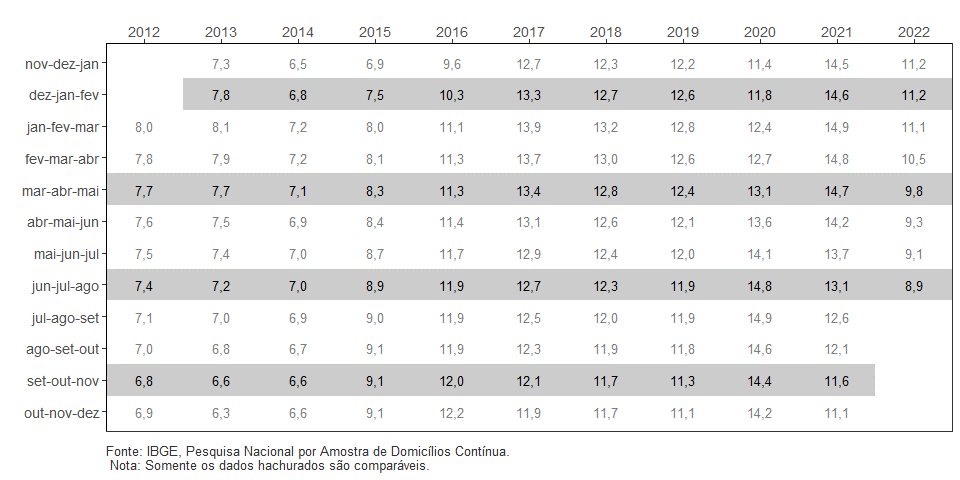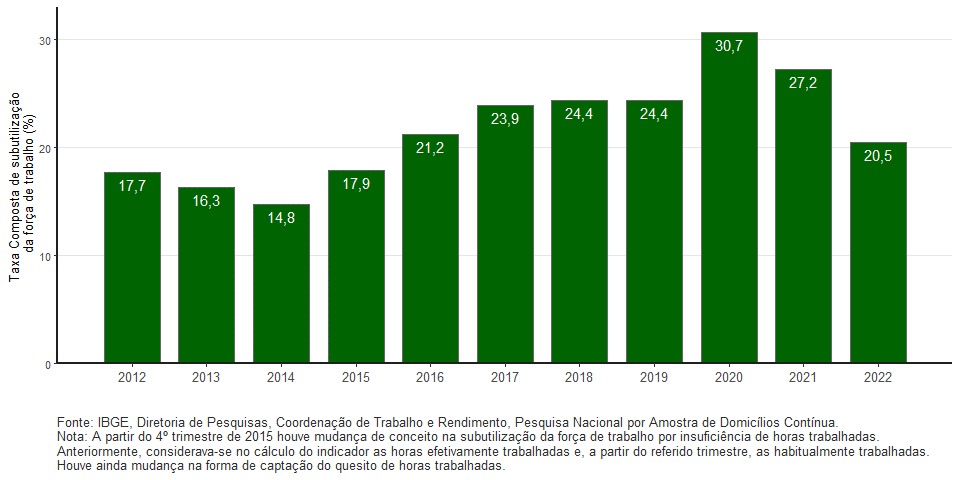Continuous PNAD: unemployment rate is 8.9%, underutilization rate is 20.5% in quarter ending in August
September 30, 2022 09h00 AM | Last Updated: October 03, 2022 03h57 PM
The unemployment rate (8.9%) of the moving quarter between June and August 2022 retreated 0.9 percentage points (p.p.) in relation to the quarter from March to May 2022 (9.8%) and 4.2 p.p. against the same period of 2021 (13.1%). The unemployed population (9.7 million persons) fell to the lowest level since the quarter ended December 2015, having dropped 8.8% (less 937 thousand persons) in the quarter and 30.1% (less 4.2 million) in the year.
| Indicator/Period | Jun-Jul-Aug 2022 | Mar-Apr-May 2022 | Jun-Jul-Aug 2021 |
|---|---|---|---|
| Unemployment rate | 8.9% | 9.8% | 13.1% |
| Underutilization rate | 20.5% | 21.8% | 27.2% |
| Uusual real earnings | R$2,713 | R$2,632 | R$2,730 |
| Change of usual earnings in relation to: | 3.1% | - | |
The employed population (99.0 million) was a record in the time series started in 2012, with a rise of 1.5% (more 1.5 million) against the previous quarter and of 7.9% (more 7.3 million) in the year.
The employment-population ratio - percentage of employed persons in the population at working age - was 57.1%, rising 0.7 p.p in the quarter and 3.7 p.p. in the year. It was the highest level since the quarter ended in December 2015.
The composite underutilization rate (20.5%) was the lowest one since the quarter ended in May 2016, falling 1.3 p.p. in the quarter and 6.6 p.p. in the year. The underutilized population (23.9 million persons) dropped 5.8% (less 1.5 million) in the quarter and 23.6% (less 7.4 million) in the year.
The time-related underemployed population (6,4 million persons) dropped 3.7% (less 245 thousand persons) in the quarter and 18.2% (less 1.4 million persons) in the year. It was the lowest contingent since the quarter ended in September 2020.
The population outside the workforce (64.6 million persons) remained stable against the previous quarter and retreated 2.3% (less 1.5 million persons) in the year.
The discouraged population (4.3 million persons)remained stable against the previous quarter and dropped 18.5% (less 970 thousand persons) in the annual comparison.
The percentage of discouraged persons in the workforce (3.8%) remained stable against the previous quarter and dropped 0.9 p.p. against the same quarter a year ago.
The number of workers with a formal employment contract in the private sector (except domestic workers) was 36.0 million persons, having increased 1.1% (398 thousand persons) against the previous quarter and 9.4% (more 3.1 million persons) in the annual comparison.
The number of persons employed without a formal contract in the private sector (13.2 million persons) was the highest in the time series initiated in 2012, and recorded an increase of 2.8% in the quarter (more 355 thousand persons) and 16.0% (1.8 million persons) in the year.
The number of self-employed persons was 25.9 million persons. It remained stable in the comparison with the previous quarter, whereas it advanced 2.4% (more 616 thousand persons) in relation to the same period of 2021.
The number of domestic workers (5.9 million persons) remained stable against the previous quarter and increased 10.5% (more 557 thousand persons) in the year.
The number of employers (4.3 million persons) remained stable compared with the previous quarter and rose 15.1% (565 thousand persons) in the year. The number of those employed in the public sector (12.1 million) grew 4.1% in the quarter and 7.7% in the year.
The informality rate was 39.7% of the employed population against 40.1% in the previous quarter and 40.6% in the same quarter of 2021. The number of informal workers hit 39.3 million.
The usual real earnings (R$2,713) grew 3.1% over the previous quarter and stood stable in the annual comparison. The usual real wage bill (R$263.5 billion) grew 4.7% against the previous quarter and 7.7% in the annual comparison.

Estimated at 108.7 million persons in the moving quarter between June and August 2022, the workforce (employed and unemployed persons) increased 0.5% (560 thousand persons) in comparison with the quarter between March and May and 2.9% (3.1 million persons) against the same quarter of 2021. It was the greatest number of persons in the workforce of the time series started in 2012.
Trade, repair of motor vehicles and motorcycles (3.0%, or more 566 thousand persons), Public administration, defense, social security, education, human health and social services (2.9% or more 488 thousand persons) and Other services (4.1% or more 211 thousand persons) were the groups of activities that increased over the previous moving quarter. The other groups did not record significant changes.
Against the quarter ended in August 2021, increases were observed in: General Industry (6.5% or more 772 thousand persons), Construction (4.2% or more 297 thousand persons), Trade, repair of motor vehicles and motorcycles (10.4% or more 1.8 million persons), Transportation, storage and mailing (9.5% or more 451 thousand persons), Lodging and food (14.2% or more 668 thousand persons), Information, Communication and Financial, Real Estate, Professional and Administrative Activities (5.6% or more 622 thousand persons), Public administration, defense, social security, education, human health and social services (8.6% or more 1.4 million persons), Other services (22.6% or more 985 thousand persons) and Domestic services (10.3% or more 550 thousand persons). The other groups did not post any statistically-significant change.

Concerning the usual real average earnings (R$2,713) against the previous moving quarter, it increased in Agriculture, livestock, forestry, fishery and aquaculture (7.2% or more R$123), Industry (4.4% or more R$111), Trade, repair of motor vehicles and motorcycles (3.5% or more R$77) and Information, communication, financial, real estate, professional and administrative activities (5.5% or more R$205). The other groups did not post any statistically-significant change.
Compared with the same quarter of 2021, it increased in Agriculture, livestock, forestry, fishery and aquaculture (9.5% or more R$158), Trade, repair of motor vehicles and motorcycles (5.2% or more R$110) and Domestic services (2.9% or more R$30). The group of Public administration, defense, social security, education, human health and social services recorded a decrease (7.7% or less R$315).
Among the employment types over the previous quarter, it increased in the following categories: Workers with a formal contract in the private sector (2.0% or more R$51) and Employers (11.5% or more R$689). The other categories did not record significant changes.
The comparison with the quarter between June and August 2021 pointed out an increase in the category of Domestic workers (2.9% or more R$30).

